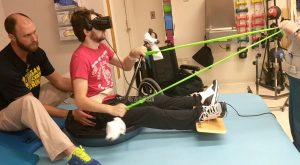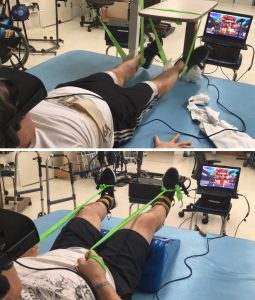Interest in using virtual reality as a medical tool has led to some misconceptions, Mr. Ferguson said. First, one’s very definition of virtual reality could be wrong. It doesn’t necessarily mean completely stepping into a digital world with no sign of the real world anywhere around you. Virtual reality can be non-immersive, such as a game played on a tablet or smartphone.2

Michael Blackstock, MS, OTRL, works with a patient using a virtual reality headset while seated on an inverted Bosu ball.
Then there’s mixed reality, a combination of the real world and virtual elements, as well as immersive virtual environments, in which displays worn on the head, with or without tracking of body movements as you move through that virtual world.
Most of the research done on virtual reality actually involves a screen and not a fully immersive environment.3
“When you’re reading an article that says ‘virtual reality,’ you have to look at [it],” Mr. Ferguson said. “Is it immersive or non-immersive? Is it mixed reality? And if it is, what kind of mixed reality? All of these things you have to think about because we interact with it very differently based on the context that it gives you.”
“More and more people are using this in the clinic,” he said. “But they’re reading that research, and they’re applying it wrong, or they’re not reading the research at all.”
Virtual Reality as Adjunct Treatment

Engaging with a screen to play a game that involves a motor function needing improvement can help the patient forget—or least not mind as much—that they’re making an effort.
Crucially, he said, virtual reality is typically used only in support of other forms of occupational or physical therapy.
“We need to connect it to a goal,” he said. “The research tells us that the virtual reality is not the treatment. It’s an adjunct treatment to what you’re doing. What’s important is the goal and strategies that you’re using to achieve the goal.”
Mr. Ferguson described virtual reality—and particularly the immersive version—as context, but a powerful one.
“The great thing—and the thing that gives you so much therapeutic power in this context—is it doesn’t have to obey the laws of physics. You can do some crazy things in the virtual context that you can’t do in the real world. And it opens up and changes the way we perceive things and think about things,” said Mr. Ferguson.


